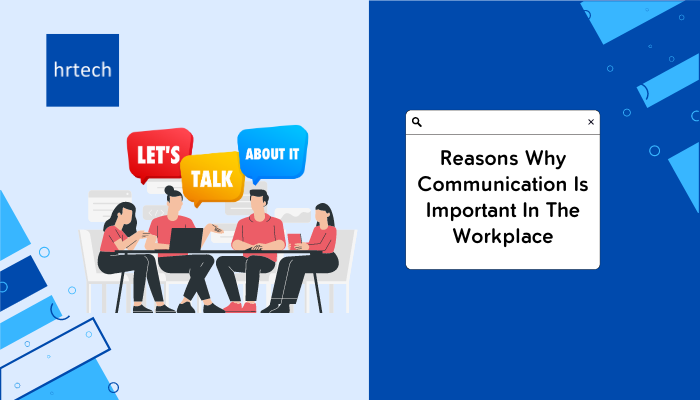Did you know? More than 8 in 10 employees consider lack of effective communication as one of the important reasons why many workplaces fail. Clear and effective communication in the workplace is crucial for a well-functioning team.
Good communication leads to better collaboration, increased productivity, and a positive work environment. When everyone understands their role and responsibilities, projects are completed more efficiently, and misunderstandings are minimized.
Let’s dive in and learn more about workplace communication, why it’s important and some best practices for effective communication.
What Is Effective Communication In The Workplace?
Effective communication in the workplace means sharing ideas and information clearly and accurately with co-workers, managers, other team members, and customers. It covers everything—from just talking to listening, writing, body language, and even online messaging.
It ensures that all team members are on the same page, reducing errors and confusion. This promotes a culture of openness and trust, crucial elements for a successful organization. Teams that communicate well can overcome challenges and adapt to changes quickly. Communication helps in sharing ideas, problem-solving, and making informed decisions.
Types of Workplace Communication:
- Verbal Communication: Speaking directly to someone. Examples include meetings, phone calls, and video conferences.
- Written Communication: Sharing information in written forms. Examples include emails, reports, and instant messages.
- Non-Verbal Communication: Using body language. Examples include facial expressions, eye contact, and posture.
- Visual Communication: Using images and graphics. Examples include charts, diagrams, and presentations.
Verbal Communication:
Face-to-face and phone conversations allow for immediate feedback. This helps in clarifying points quickly. It also conveys tone and emotion.
Written Communication:
Emails and reports are important for record-keeping. They allow the sender to carefully choose their words. This type of communication is useful for complex information.
Non-Verbal Communication:
Body language and facial expressions add meaning to words. For example, a nod can indicate agreement while crossed arms might show resistance. It helps in understanding true feelings.
Visual Communication:
Graphs, charts, and images make data easy to understand. Visual aids can highlight important details. They are helpful in presentations and reports.
Combining different types of communication can help make the message clear and engaging.
What Are The Examples Of Effective Communication In The Workplace?
Example Sentences of Effective Communication:
| Wrong Sentence: | Right Sentence: |
| “I need this report ASAP.” | “Could you please complete the report by 3 PM today?” |
| “You’re late again!” | “I noticed you arrived after 9 AM today. Is there any support you need to arrive on time?” |
| “Your idea won’t work.” | “Can we explore the challenges of this idea and brainstorm solutions?” |
| “I don’t care how you do it, just do it.” | “Let’s discuss the steps needed to complete this task effectively.” |
| “Good job on the project.” | “Your detailed analysis in the project was excellent. Great job!” |
It’s essential to be clear and specific in requests. Vague requests may lead to misunderstandings. Showing empathy can make feedback constructive. Addressing issues kindly encourages improvement.
Respectful language promotes a better work environment. It shows consideration for others’ ideas. Proposing discussions instead of orders leads to more effective collaboration. It involves everyone in the process.
Providing specific praise highlights what was done well. This reinforces desired behaviors.
12 Reasons Why Communication Is Important In The Workplace
1. Conflict Resolution
Clear communication helps resolve conflicts by making sure all parties understand each other’s viewpoints. Misunderstandings are reduced, and solutions can be reached faster.
When team members communicate effectively, they can express their concerns without confrontation, making it easier to solve the issues at hand.
2. Improves Productivity
Effective communication simplifies the workflow and reduces errors. When employees understand their tasks and the expectations, they perform better.
Clear instructions and feedback allow for smoother workflows. For example, a well-communicated project plan ensures all team members are on the same page, which improves efficiency.
3. Increased Employee Job Satisfaction
Employees feel more valued and satisfied when their voices are heard. Open lines of communication allow them to express their ideas and concerns. When management listens and responds, it builds trust, which further leads to a more positive work environment, enhancing morale and job satisfaction.
4. Lower Turnover Rate
High turnover rates can be costly. Employees are less likely to leave a company when they feel heard and understood.
Good communication develops a sense of belonging and loyalty. For instance, regular feedback and open dialogues can resolve issues before they escalate, reducing the chances of turnover.
5. Enhances Employee Engagement
Engaged employees are more committed to their work. Communication plays a key role in keeping them informed and connected to the company’s goals. When employees understand the bigger picture and their role in it, they are more motivated to contribute effectively.
6. More Innovation
Open communication encourages idea sharing. When employees feel comfortable speaking up, they are more likely to suggest new ideas and solutions. A culture that promotes communication can lead to creative problem-solving and innovation, driving the company forward.
7. Higher Adaptability
In a fast-changing environment, communication helps teams adapt quickly. Regular updates and clear instructions allow employees to understand changes and act accordingly. For example, during a company restructuring, effective communication ensures everyone knows their new roles and responsibilities.
8. Customer Satisfaction
Employee communication affects customer interactions. Clear internal communication ensures that customer-facing employees have the right information. This leads to better service and higher customer satisfaction. For instance, sales and support teams can deliver consistent messages to customers when they communicate well internally.
9. Better Knowledge Transfer And Training
Effective communication is key to training and knowledge transfer. Clear instructions and feedback help new employees learn quickly. Regular communication during training sessions helps identify and address learning gaps. For instance, mentoring programs can enhance learning through continuous dialogue.
10. Increased Employee Motivation
Motivated employees are more productive. Communication helps to explain goals and expectations clearly. Recognizing achievements and discussing career growth options can boost motivation. For example, regular performance reviews and constructive feedback keep employees motivated to improve and achieve more.
11. Improves Teamwork
Good communication is the foundation of teamwork. It ensures that everyone understands their roles and responsibilities. Facilitating regular team meetings and open discussions fosters collaboration. For instance, a project team that communicates well can work together efficiently towards a common goal.
12. Positive Workplace Culture
A positive workplace culture develops from open and honest communication. When employees feel they can speak freely, it builds a supportive environment. This positive culture can increase job satisfaction and retention. For example, regular town hall meetings where employees can ask questions and share concerns contribute to a healthy workplace culture.
How To Effectively Communicate In The Workplace?
Effective communication in the workplace is crucial for collaboration, efficiency, and a positive work environment. Both verbal and non-verbal communication play key roles, along with clear communication with customers.
Verbal Workplace Communication Best Practices
- Be Clear and Concise – Use straightforward language to ensure your message is easily understood.
- Active Listening – Pay attention to the speaker, nod, and ask questions to show engagement.
- Use Positive Language – Frame messages in a positive way to encourage and motivate.
- Feedback – Offer constructive criticism and recognize achievements regularly.
- Ask Questions – Clarify uncertainties by asking direct questions to avoid miscommunication.
- Adapt Your Communication Style – Adjust your language and tone according to your audience.
- Repeat Key Points – Emphasize important information to reinforce understanding.
- Be Approachable – Encourage open dialogue by being friendly and open.
- Use Examples – Give clear, relevant examples to support your points.
- Stick to the Subject – Keep your conversations focused on the current topic.
Non-Verbal Workplace Communication Best Practices
- Eye Contact – Maintain eye contact to show confidence and interest.
- Body Language – Use open body language; avoid crossing arms or slouching.
- Facial Expressions – Ensure your facial expressions match your words.
- Gestures – Use your hands to emphasize points but avoid overdoing it.
- Posture – Stand or sit up straight to convey professionalism.
- Distanceb – Respect personal space to make others comfortable.
- Tone of Voice – Match your tone to the message you are delivering.
- Attentive Silence – Sometimes, being silent shows you are listening and processing information.
- Appearance – Dress appropriately for the workplace to convey respect.
- Mirroring – Subtly mimic the listener’s body language to build rapport.
Best Practices For Communicating With Customers
- Be Polite and Respectful – Always use courteous language.
- Active Listening – Show customers their concerns are heard and understood.
- Clear Information – Provide precise and easy-to-follow instructions or answers.
- Empathy – Understand and acknowledge the customer’s feelings.
- Follow-Up – Ensure issues are resolved by checking back with customers.
- Personalize Communication – Use the customer’s name and tailor interactions to their needs.
- Prompt Responses – Reply quickly to customer inquiries and issues.
- Stay Positive – Keep a positive attitude, even when dealing with complaints.
- Transparent Policies – Clearly explain your company’s policies and procedures.
- Thank Customers – Express gratitude to show appreciation for their business.
Final Thoughts
So, why is communication important in the workplace?
Because effective communication in the workplace builds better relationships. It helps team members understand each other and work toward common goals. It also reduces misunderstandings and conflicts between colleagues.
Good communication also enhances productivity. Clear instructions ensure tasks are done correctly the first time. This saves time and resources. Remember, communication is not just about speaking. Listening is equally important. Being an active listener shows respect and makes others feel valued.
Employees who communicate well are often more engaged. They feel more connected to their work and team. This leads to higher job satisfaction and retention rates. In a nutshell, clear and effective communication is essential in any workplace. It benefits both the organization and its people.
Looking for more help? Our experts at hrtech can help you by understanding your unique workplace challenges and guide you in the right direction. Contact us today to learn more!





